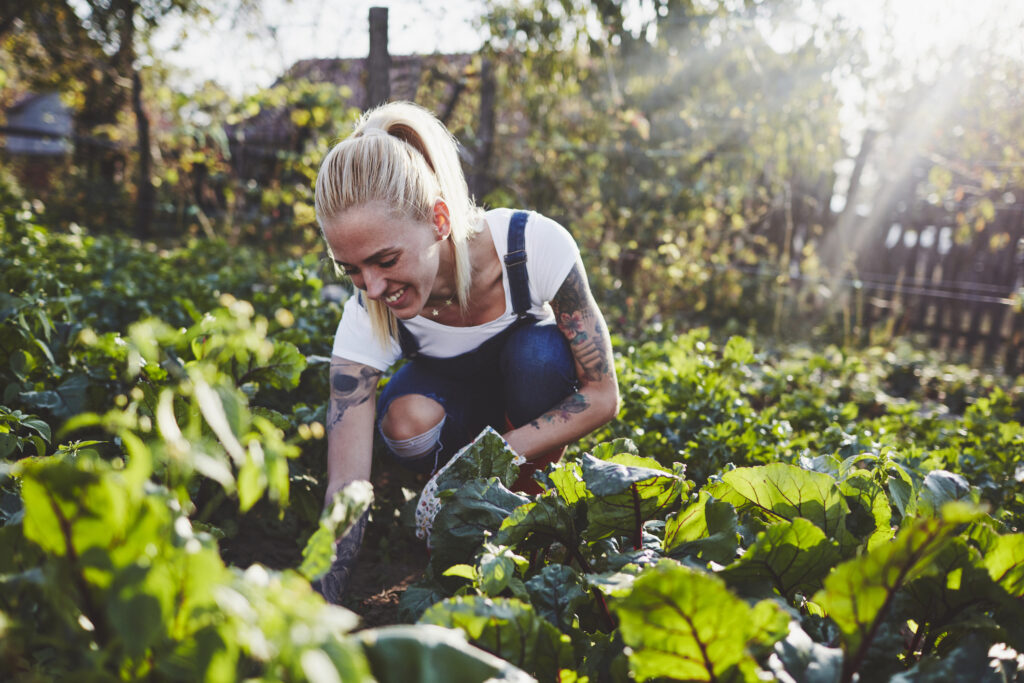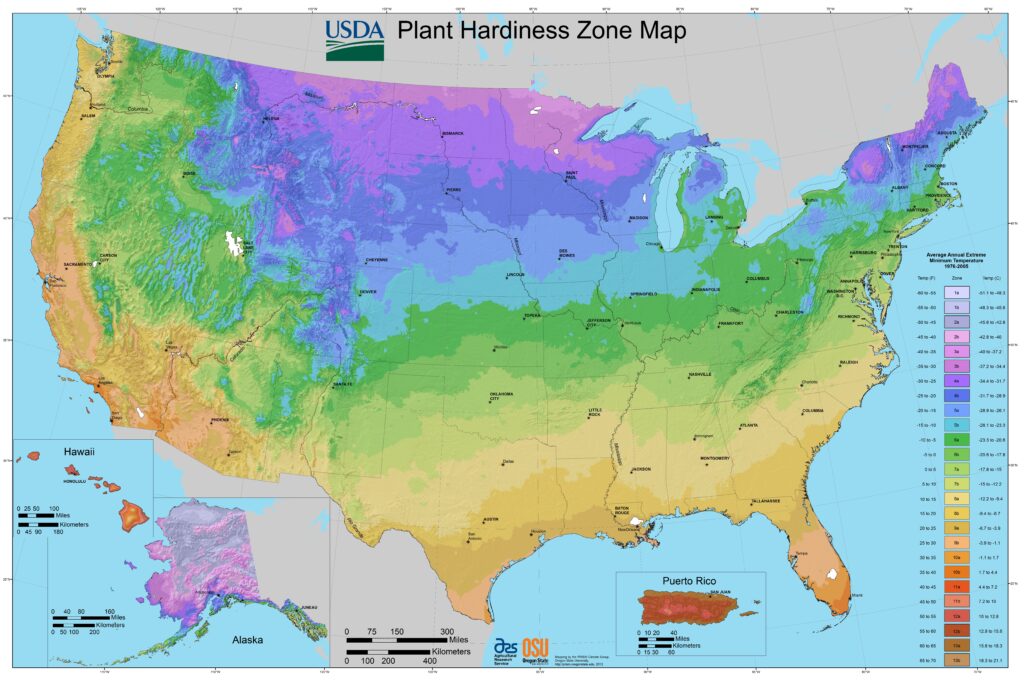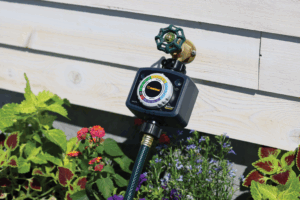
January 25, 2022
Aside from year-round warm, southern locations like Texas and Florida, you’ve probably fantasized about what your gardens will look like this spring. Gone are the days of beautifully blooming flowers and rich, full vegetables to pull off the vine and nibble on as you stroll through your botanical masterpiece. Chances are —for the majority of us — this winter has been cold, windy, and snowy leaving our plants destroyed and our soil reduced to nutrient-dead, diluted muck. However, with a little preparation and planning, there is a lot to look forward to in your gardens this spring.
Using this guide and applying the preparation needed, anyone can grow these four hardy, early-spring vegetables.
What About My Hardiness Zone?

Want to keep the map for future reference? Click below to download.
Before we get into what these vegetables are, we must first state the importance of recognizing what hardiness zone you are in — particularly for early spring gardening. The climate will largely affect what vegetables you choose to plant in order for them to thrive and produce a high yield. No one wants to put in the hard work of prepping the garden, buying expensive tools, and starting the new seeds or bulbs just to have them wither away at first frost.
The USDA Plant Hardiness Zone Map, which was developed in 2012, is the standard by which gardeners determine which plants to grow in which climates. To be specific, the map was established on the basis of the average annual minimum winter temperature, divided into 10° Fahrenheit zones. This is especially helpful as gardeners make their plant selections based on the plant’s “hardiness,” or put more simply — their ability to manage the cold. Thankfully, the four vegetables chosen in this blog are very hardy and can grow in most regions of the United States.
Note: Gardeners should keep in mind that results may vary, especially when choosing varieties that “stretch” the limitations of their rated zone.
In addition to varying results of growing plants in different regions, gardeners should also be aware that microclimates do exist. Microclimates, according to USDA, are defined as small-scale climate variations such as small “heat islands” — like those caused by concrete slabs or blacktop — and cold spots, similarly caused by localized environmental structures including hills and valleys. Due to this, no hardiness zone map will be able to match the concrete, hands-on experience of gardening in your particular region.
With that said, gardeners, plant-lovers, and hobbyists alike should at least take this first step in understanding their region and what grows best.
Planning, Preparation, & Care
After discovering the insights of growing plants best suited for your region, particularly for these four vegetables, the next step involves planning and preparation. Specifically, the planting location where the plants will grow on your property, type of soil composition they’ll need, and proper watering routine to promote adequate growth. For matters of this blog, we will only cover these sections for the vegetables chosen.
So, let’s get started!
What Are the Easiest, Early-Spring Vegetables Anyone Can Grow (in Most U.S. Regions)?
Vegetable #1: Spinach
Spinach (Spinacia oleracea) is a leafy green annual that thrives in cooler climates. There are numerous varieties of spinach, each ranging in look and color. The leaves are usually smooth with medium to dark-green tints. Spinach plants produce little yellow-green blooms on spikes before dropping seeds in hot weather. Spinach grows quickly and may be harvested in as little as one month after being sown as a seed. It thrives in most climates when planted in early spring or fall.

When Do I Plant Spinach?
When it comes to planting vegetables, there are two groups you should consider. These groups will help you understand when to plant most vegetables, not just spinach. These groups are:
Group One: These vegetables are called “cole-crops” that prefer cooler soils and cooler growing temperatures. These vegetables can be planted 1-2 weeks after Valentine’s Day. That is subject to change with your hardiness zone. Vegetables in this group include kale, collards, broccoli, cabbage, lettuce, onions, spinach, brussels sprouts, and more.
Group Two: The second group of vegetables prefer warmer soils and should be planted 2-3 weeks into March. These include beets, swiss chard, parsnips, potatoes, carrots, and more.
As mentioned above, spinach is in group one and should be planted from seed around the end of February. Depending on your hardiness zone, you may want to plant closer to Valentine’s Day if you are in zones 7-11, and closer to March if you are in zones 2-6.
Spinach Care/ Maintenance
Planting Location: Planting spinach in a sunny location with adequate soil drainage is recommended. Growing in a container is also a possibility if you prefer that method. Spinach plants will bolt, or shoot up a flower spike, and go to seed, as the temperature warms. Should you want to delay this, planting under the partial shade of taller plants may help. Make sure that you are growing spinach in temperatures between 50° F and 60° F, as they can only tolerate light frosts.
Seeds should be placed 1/2 to 1 inch deep and 12 to 18 inches apart, in rows separated by 20-30 inches. Aerosol garden chalk (found at most nurseries and garden centers) or simply placing markers where the seeds should go are good ways to keep track of what seeds are what. There will be no need for a structure support system.
Soil Composition: Spinach prefers soil that is well-draining, nutrient-rich, and loamy. Ensure the soil has fairly neutral pH level; 6.0-8.0 will do.
Watering: Regularly water spinach to keep the soil equally wet but not waterlogged. In warmer climates, it’s critical to keep your plants well-watered to avoid bolting. In general, spinach needs 1 to 1 ½ inches of water each week. For optimal results, consider weaving Melnor® Soaker Hoses around your rows of spinach seeds to achieve deep, thorough watering. Our soaker hose lengths are available in 25, 50, and 75 Ft.

For even more convenience, attach them to a Melnor® Smart Timer to deliver ideal, scheduled watering without further thought or attention.

Watering multiple times a week is preferred to one big, weekly watering for spinach to grow effectively. That is why smart timers, such as the ones made by Melnor® that manage specified watering times on scheduled intervals, can help to make gardening so much easier.
A layer of mulch around the plants might also assist to keep the soil cool and moist during breaks from watering sessions.
How Long Does Spinach Take to Grow?
Given the right growing circumstances, and a little help from Melnor® watering tools, you can expect to harvest spinach in four to six weeks after planting. Spinach completes is life cycle in one growing season, making it an annual. That means if you want to grow more spinach, you will need to re-plant the following season.
Vegetable #2: Brussels Sprouts

Brussel sprouts are named after the city of Brussels, Belgium, where they have been eaten since the 14th century. However, they are believed to have originated in ancient Rome. Brussels sprouts, which are part of the cabbage family, may be easily grown in almost any home vegetable garden if you have patience; they are slow-growing plants that require extensive growth seasons.
If you’ve only seen brussels sprouts in the grocery store, the distinctive beauty of their plant structure will delight you. Robust, 30-inch-tall stalks, bold, projecting stems, and broad, cabbage-like leaves will most certainly leave you in awe. The leaves are also edible and may be cooked in the same way as your other hardy greens.

When Do I Plant Brussels Sprouts?
Brussels sprouts, like spinach, are in group one and should be treated the same. Make sure to plant them from seed around early March, with similar hardiness zone variations to spinach. However, they are a little different. Unlike spinach and most other “cole-crops,” brussels sprouts are best started indoors as early as 4-6 weeks prior to planting them outside. This is because they require longer growing seasons. So, starting brussels sprouts from seed indoors can save you time when you’re ready to harvest your vegetables.
Brussels Sprouts Care/ Maintenance
Planting Location: When planting your brussels sprouts, place the seeds about 1 to 1 ½ inches deep and 2-3 feet apart in rows spaced 2 feet apart. Easily keep track of where you want to place your seeds by using metal markers or aerosol garden chalk. Due to their taller growing heights, support structures may be required. Brussels sprouts require a lengthy growth season of at least 80 days so remember to be patient. In colder areas, brussels sprout seeds can be started inside in early May and transplanted to the garden in mid-June, or four months before the first fall frost. Only plant outside after the final spring frost has passed. Make sure your plants spend all the essential harvest days outside. Fall planting is favored in hotter areas. You should be able to directly seed in the middle of summer for a crop to harvest in the late fall or early winter.
They prefer full sun and require at least 6 hours of sunlight every day to thrive. Subsequently, the sprouts’ maturation will be slowed if they are exposed to too much shade.
Soil Composition: Brussels sprouts prefer soil that is slightly acidic to neutral in pH, fertile, well-drained, and wet, with lots of organic matter. The pH level of the soil should be between 6.5 and 7.0. Organically rich nutrients will help them keep the moisture they require for their large development.
Brussels sprouts like a solid but not overly pressed soil environment. Lightly pat the soil to give the brussels sprouts their preferred soil structure.
Watering: Water your brussels sprouts once per week with 1 to 1 ½ inches of water. Try to keep the soil moist but not waterlogged. Mulch may help with retaining the soil’s moisture.
How Long Do Brussels Sprouts Take to Grow?
Brussels sprouts require long growth seasons close to 80 days, or three to four months after they have been transplanted. Though commonly grown as annuals, they are biennial plants that will continue producing flowers if grown for two seasons. Initially, they grow tall and don’t start sprouting until they’re nearly full grown. Each sprout emerges from the junctions of the leaves and stem. They start developing at the bottom of the plant and work their way up. When the lowest sprouts reach the size of ping-pong balls, begin harvesting. Pick the sprouts before they become too huge and begin to break and taste harsh.
Vegetable #3: Radish

When you imagine a radish (Raphanus sativus), you probably picture a tiny, round, red, and pungent root vegetable, such as the one pictured above! Though there are various types that range in appearance, the most common radishes match that description. Other varieties can be round or oblong, hot or mild, red, pink, purple, white, or multi color.
Radishes, like cauliflower, cabbage, broccoli, collards, and kale are annual vegetables that belong to the Brassicaceae family. They’re planted in the early to mid-spring (for a spring yield) or late summer (for a fall yield). They, along with others in the Brassicaceae family, grow very quickly with some of the smaller cultivars maturing in as little as 20 days! The bigger varieties of radishes might take up to 60 days to mature.

When Do I Plant Radishes?
Radishes should be planted from seed about 2-4 weeks after the start of February. Pay attention to your hardiness zone and adjust for different climates. If you live in a warmer climate (zones 7-11), make sure to plant radishes around Valentine’s Day. If you live in a colder climate (zones 2-6), you should plant from seed closer to the start of March. They prefer to grow in temperatures between 40°F and 65° F.
Radish Care & Maintenance
Planting Location: Choose a sunny location with soil that is rich, loose, and drains well. Growing in a container is also a possibility if you prefer that method. Radishes may be crammed in between slower-to-sprout plants in the vegetable garden, such as brussels sprouts, because they develop more quickly. Before the other plants require the area, the radishes will be picked. Radishes are also useful for loosening and cultivating soil. Just make sure your radishes aren’t shaded by that bigger, surrounding vegetation.
Seeds should be spaced 4 to 6 inches apart and 1/2 inch to 1 inch deep. The rows should be about a foot apart. Keep track of where your seeds are at by using aerosol garden chalk (available at most nurseries and garden shops) or simply setting markings where the seeds should go. There will be no need for a structural support system.
Soil Composition: Radishes thrive in soil that is nutrient-rich, loamy or sandy, well-draining, and slightly acidic to neutral pH. The soil shouldn’t be compacted since this will prevent the roots from growing properly.
Watering: Radish plants require 1 inch of water each week on average. Too dry soil can lead the plant to bolt (go to seed) and spoil the radishes’ flavor, while too damp soil can cause the roots to rot. This can be easily regulated to ensure performance and growth of your radishes by using a Melnor® Smart Timer and Oscillating Sprinkler. The MiniMax™ Turbo Oscillating Sprinkler on Step-Spike, perfect for early-spring vegetable gardens, is pictured below.

Watch the MiniMax™ Turbo Oscillating Sprinkler in action, click here!
A mulch layer surrounding the plants might also assist in keeping the soil moist.
How Long Do Radishes Take to Grow?
If the above growing conditions are met, many radish varieties take an average of 30-60 days to be ready for harvest. Like spinach, radishes are annuals completing their life cycle in one growing season which means if you want to grow more radishes, you’ll need to re-plant next season.
Vegetable #4: Turnip

Although we are most familiar with the white and purple tennis-ball-sized turnips seen in grocery stores, there are a wide range of turnips available, including small, soft ping-pong-ball-sized turnips. Turnips (Brassica rapa), like radishes, belong to the Brassicaceae family, and its edible green tops are similar in taste to mustard greens.
The leaves of a turnip are light green and somewhat hairy. They also grow into an elongated oval shape with serrated or wavy borders as they mature. Turnip roots are usually white or yellow, with the section that protrudes above ground becoming purple or green due to exposure to the sunlight. Turnip blossoms are tiny and yellow if encouraged to bloom. The four petals of Brassica plants form a cross, which is why they are also known as cruciferous vegetables.

When Do I Plant Turnips?
Like the other vegetables listed in this guide, Turnips should be planted from seed about 1-2 weeks after the start of February. Don’t forget to adjust planting times for your hardiness zone as mentioned previously. Turnips prefer cool weather, close to 60° F, to form large bulbs.
Turnip Care/ Maintenance
Planting Location: Plant seeds about ¼ to ½ inch deep and 1 to 1 ½ inches apart in rows. The rows should be spaced 10-16 inches apart from one another. You may need a support structure for turnips that grow 18+ inches tall. Again, you can easily keep track of where you want to place your seeds by using aerosol garden chalk or simple garden markers.
Soil Composition: Turnips take a better growth pattern in soil that has a slightly acidic pH; aim for 6.0 to 6.5 in your soil. To keep the roots from rotting, make sure the soil is well-draining.
Watering: For proper root development, at least 1 inch of water each week is required. Turnips require a lot of water to develop fast, and a rich soil will help them do so. The roots are more bitter under dry circumstances, while the ideal flavor comes from consistent water. Easily achieve this by incorporating Melnor® soaker hoses and sprinklers around the planting location.
How Long Do Turnips Take to Grow?
Turnips mature very fast, sometimes close to only two months. Similar to the other vegetables listed, turnips are annual plants completing their life cycle in one growing season. So, if you want to more turnips after you have harvested, you’ll need to re-plant them next season.
Conclusion
After reading our blog, we hope you enjoyed your time and learned a thing or two about cool-season vegetables. If your curiosity has been peaked and you are interested in learning more, download this free Utah State University “Vegetable Planting Guide,” which explains in more detail about other vegetables you can plant and when.

We are all looking forward to the beautiful spring weather this year! Just imagine the birds are chirping, your new plant growth is poking through the topsoil, and everything is coming alive in your new botanical masterpiece.
We wish you the best of luck, should you decide to undertake this gardening challenge, and would love to see pictures of your success story along the way!
Sources
Cabi.org. (2021, November 17). Spinacia oleracea (spinach). Retrieved January 13, 2022, from https://www.cabi.org/isc/datasheet/51117
Cabi.org. (2019, November 22). Raphanus sativus (radish). Retrieved January 13, 2022, from https://www.cabi.org/isc/datasheet/46796
Cabi.org. (2019, November 22). Brassica rapa subsp. rapa (turnip). Brassica rapa subsp. Rapa (turnip). Retrieved January 13, 2022, from https://www.cabi.org/isc/datasheet/10118
Iannotti, M. (2021, May 24). Tips for growing Tasty Turnips. The Spruce. Retrieved January 13, 2022, from https://www.thespruce.com/how-to-grow-turnips-1403468
Iannotti, M. (2021, September 22). How to grow spinach. The Spruce. Retrieved January 13, 2022, from https://www.thespruce.com/growing-spinach-1403448
Iannotti, M. (2021, September 22). How to grow beets. The Spruce. Retrieved January 13, 2022, from https://www.thespruce.com/how-to-grow-beets-in-the-home-garden-1403456
Iannotti, M. (2021, October 29). How to grow radishes. The Spruce. Retrieved January 13, 2022, from https://www.thespruce.com/growing-radishes-in-the-home-vegetable-garden-1403477
Clausing, N. (2021, March 18). Spring is coming, so take care of these gardening checklist items. Sunset Magazine. Retrieved January 13, 2022, from https://www.sunset.com/home-garden/garden-basics/spring-gardening-checklist-to-do#garden-gloves
Loveland, N., Thatcher, D., Fillingim, J., & Mickelsen, K. (2021, March 30). Early Spring Gardening: What to plant and when. IFA Country Stores. Retrieved January 13, 2022, from https://ifacountrystores.com/2019/gardening/early-spring-gardening/
Iannotti, M. (2021, June 16). What vegetables should I plant in early spring? The Spruce. Retrieved January 13, 2022, from https://www.thespruce.com/cool-weather-vegetables-1402171
says:, T., Says:, K., & says:, D. H. (2021, July 29). Spring Gardening: March garden checklist zones 6-8. Spring Gardening: March Garden Checklist Zones 6-8. Retrieved January 13, 2022, from https://www.kellogggarden.com/blog/gardening/march-garden-checklist-zones-6-8/
Johnson, E. (2020, July 17). Grow a garden salad with these 13 vegetables you can plant in early spring. Apartment Therapy. Retrieved January 13, 2022, from https://www.apartmenttherapy.com/vegetables-to-plant-early-spring-36734746
Encyclopedia Britannica, T. E. of. (2019, November 26). Brussels sprouts. Encyclopædia Britannica. Retrieved January 13, 2022, from https://www.britannica.com/plant/Brussels-sprouts
USDA.gov, T. E. of. (n.d.). USDA Plant Hardiness Zone Map. Home. Retrieved January 13, 2022, from https://planthardiness.ars.usda.gov/
Rose, S. (2021, February 19). 10 tasks to prepare your Spring Garden. Garden Therapy. Retrieved January 13, 2022, from https://gardentherapy.ca/10-spring-garden-tasks/





